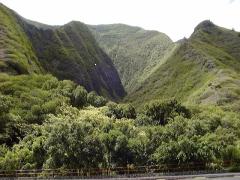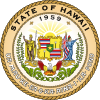Portal:Hawaii
The Hawaii Portal Hawaii (/həˈwaɪ.i/ hə-WY-ee; Hawaiian: Hawaiʻi [həˈvɐjʔi, həˈwɐjʔi]) is an island state of the United States, in the Pacific Ocean about 2,000 miles (3,200 km) southwest of the U.S. mainland. One of the two non-contiguous U.S. states (alongside Alaska), it is the only state not on the North American mainland, the only state that is an archipelago, and the only state in the tropics. Hawaii consists of 137 volcanic islands that comprise almost the entire Hawaiian archipelago (the exception, which is outside the state, is Midway Atoll). Spanning 1,500 miles (2,400 km), the state is physiographically and ethnologically part of the Polynesian subregion of Oceania. Hawaii's ocean coastline is consequently the fourth-longest in the U.S., at about 750 miles (1,210 km). The eight main islands, from northwest to southeast, are Niʻihau, Kauaʻi, Oʻahu, Molokaʻi, Lānaʻi, Kahoʻolawe, Maui, and Hawaiʻi, after which the state is named; the latter is often called the "Big Island" or "Hawaii Island" to avoid confusion with the state or archipelago. The uninhabited Northwestern Hawaiian Islands make up most of the Papahānaumokuākea Marine National Monument, the largest protected area in the U.S. and the fourth-largest in the world. Of the 50 U.S. states, Hawaii is the eighth-smallest in land area and the 11th-least populous; but with 1.4 million residents, it ranks 13th in population density. Two-thirds of Hawaii residents live on O'ahu, home to the state's capital and largest city, Honolulu. Hawaii is among the country's most demographically diverse states, owing to its central location in the Pacific and over two centuries of migration. As one of only seven majority-minority states, it has the only Asian American plurality, the largest Buddhist community, and largest proportion of multiracial people in the U.S. Consequently, Hawaii is a unique melting pot of North American and East Asian cultures, in addition to its indigenous Hawaiian heritage. Settled by Polynesians sometime between 1000 and 1200 CE, Hawaii was home to numerous independent chiefdoms. In 1778, British explorer James Cook was the first known non-Polynesian to arrive at the archipelago; early British influence is reflected in the state flag, which bears a Union Jack. An influx of European and American explorers, traders, and whalers soon arrived, leading to the decimation of the once-isolated indigenous community through the introduction of diseases such as syphilis, tuberculosis, smallpox, and measles; the native Hawaiian population declined from between 300,000 and one million to less than 40,000 by 1890. Hawaii became a unified, internationally recognized kingdom in 1810, remaining independent until American and European businessmen overthrew the monarchy in 1893; this led to annexation by the U.S. in 1898. As a strategically valuable U.S. territory, Hawaii was attacked by Japan on December 7, 1941, which brought it global and historical significance, and contributed to America's entry into World War II. Hawaii is the most recent state to join the union, on August 21, 1959. In 1993, the U.S. government formally apologized for its role in the overthrow of Hawaii's government, which had spurred the Hawaiian sovereignty movement and has led to ongoing efforts to obtain redress for the indigenous population. (Full article...) This is a Featured article, which represents some of the best content on English Wikipedia..
On 9 February 2001, about nine nautical miles (17 km; 10 mi) south of Oahu, Hawaii, in the Pacific Ocean, the United States Navy (USN) Los Angeles-class submarine USS Greeneville (SSN-772) collided with the Japanese fishery high-school training ship Ehime Maru (えひめ丸) from Ehime Prefecture. In a demonstration for some VIP civilian visitors, Greeneville performed an emergency ballast blow surfacing maneuver. As the submarine shot to the surface, she struck Ehime Maru. Within ten minutes of the collision, Ehime Maru sank. Nine of the thirty-five people aboard were killed: four high school students, two teachers, and three crew members. Many Japanese people, including government officials, were concerned by news that civilians were present in Greeneville's control room at the time of the accident. Some expressed anger because of a perception that the submarine did not try to assist Ehime Maru's survivors and that the submarine's captain, Commander Scott Waddle, did not apologize immediately afterwards. The USN conducted a public court of inquiry, blamed Waddle and other members of Greeneville's crew, and dealt non-judicial punishment or administrative disciplinary action to the captain and some crew members. After Waddle had been questioned by the Naval Board of Inquiry, it was decided that a full court-martial would be unnecessary, and he was forced to retire and given an honorable discharge. (Full article...)
This is a Good article, an article that meets a core set of high editorial standards.
The Lānaʻi hookbill (Dysmorodrepanis munroi) is an extinct species of Hawaiian honeycreeper. It was endemic to the island of Lānaʻi in Hawaiʻi, and was last seen in the southwestern part of the island. George C. Munro collected the only known specimen of this species in 1913, which is housed in the Bernice P. Bishop Museum in Honolulu, and saw the species only twice more, once in 1916 and for a final time in 1918. No other sightings have been reported. They inhabited montane dry forests dominated by ʻakoko (Euphorbia species) and ōpuhe (Touchardia sandwicensis). The Lānaʻi hookbill was monotypic within the genus Dysmorodrepanis and had no known subspecies. Its closest relative is believed to be the ʻōʻū, and some early authors suggested that the Lānaʻi hookbill was merely a deformed ʻōʻū. The Lānaʻi hookbill was a plump, medium-sized bird with greenish olive upperparts and pale whitish yellow underparts. It also had a yellow or white superciliary line and a white chin and throat. The wings also had a distinctive and conspicuous white wing patch. The hookbill's distinguishing characteristic was its heavy, parrotlike bill, which had the mandibles hooking sharply towards each other, leaving a gap between them when the beak was closed. As the bird became extinct before significant field observations could be made, not much is known about its behavior. The Lānaʻi hookbill is only known to have eaten the fruit of the ōpuhe; however, it is unlikely that its unique bill would have developed to eat fruit, and it may have been a snail specialist. The hookbill has not been seen since 1918, and by 1940 nearly all of Lānaʻi's forests were converted into pineapple fields, destroying the bird's habitat. The combination of habitat destruction and the introduction of feral cats and rats are thought to have led to the Lānaʻi hookbill's extinction. (Full article...) Selected Picture - 'Ōlelo (Language) -This section is here to highlight some of the most common words of the Hawaiian Language, ʻŌlelo, that are used in everyday conversation amongst locals.
Hou
New, fresh, again, more State Facts
State Symbols:
Selected article -Israel Kaʻanoʻi Kamakawiwoʻole (May 20, 1959 – June 26, 1997), also called Braddah IZ or just simply IZ, was a Native Hawaiian musician and singer. He achieved commercial success and popularity outside of Hawaii with his 1993 studio album, Facing Future. His medley of "Somewhere Over the Rainbow/What a Wonderful World" was released on his albums Ka ʻAnoʻi and Facing Future, and was subsequently featured in various media. The song has had 358 weeks on top of the World Digital Songs chart, making it the longest-leading number-one hit on any of the Billboard song charts. Kamakawiwoʻole is regarded as one of the greatest musicians from Hawaii and is the most successful musician from the state. Along with his ukulele playing and incorporation of other genres, such as jazz and reggae, Kamakawiwoʻole remains influential on Hawaiian music. He was named "The Voice of Hawai‘i" by NPR in 2010. (Full article...) Did you know? -
Hawaii News
Wikinews Hawaii portal
Quotes - "I am always telling our federal agencies and contractors that if they bring work to Hawaiʻi, they need to hire Hawaiʻi residents." — Senator Daniel Akaka On this day...There are no anniversaries listed for this day. Related portalsTopicsCategoriesAssociated WikimediaThe following Wikimedia Foundation sister projects provide more on this subject:
SourcesDiscover Wikipedia using portals |
























